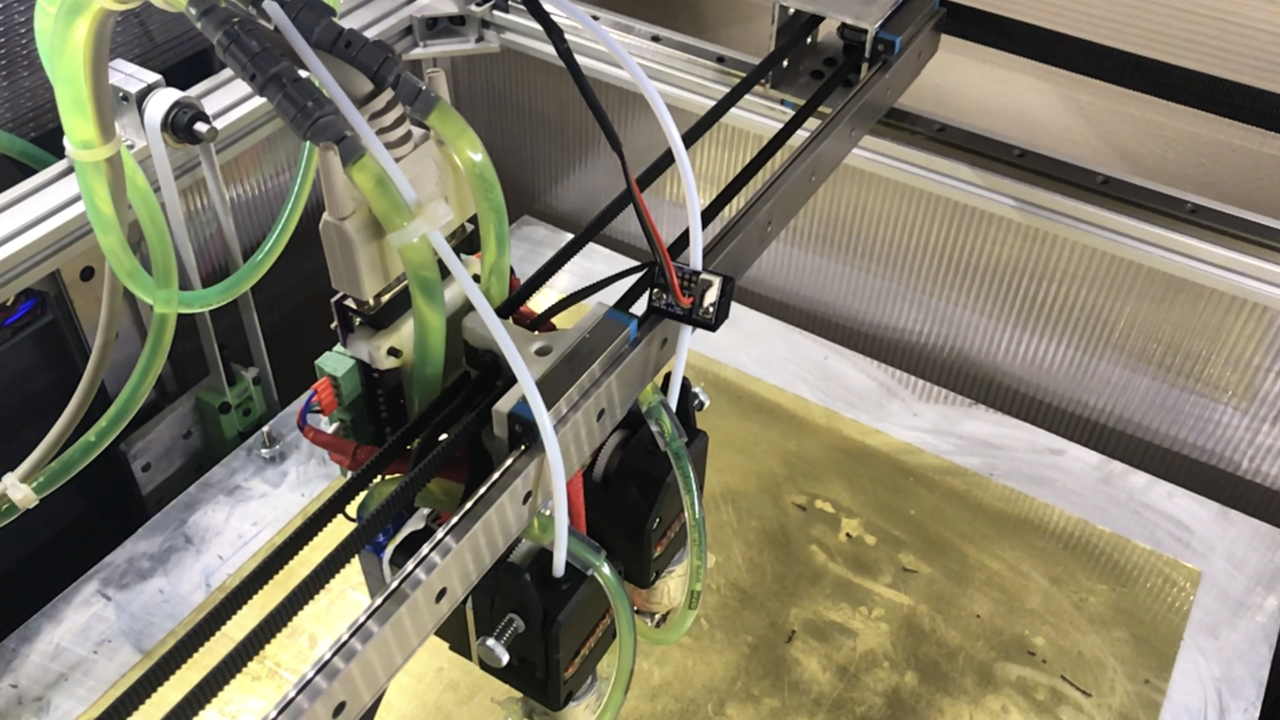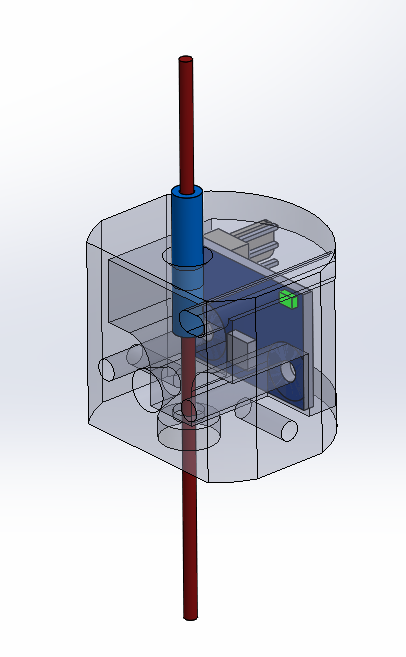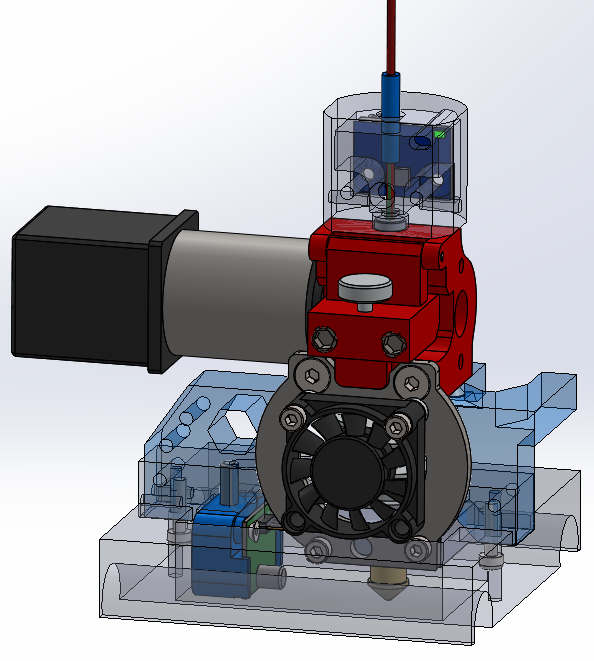Laser Filament Monitor - test results
-
@kraegar But then again the sensor - given it would be sufficiently accurate - could assist in tuning non-linear extrusion beforehand.
Let's wait and see where we get with it.
Probably tomorrow, I will eventually print the housing for my sensor. Loaded black filament tonight and redid bed leveling so I am set.

-
Yep, I'm thinking if we find a "best" filament for monitoring, that would be the ideal one to use for tuning non-linear extrusion.
-
Ok, So here is another test:
Black ABS - Matterhackers - Benchy Test
Calibrated Steps/mm 441M591 D0
Duet3D laser filament monitor on endstop input 3, disabled, allowed movement 40% to 120%, check every 3.0mm, current position -9.6, brightness 94, shutter 17, measured minimum 94%, average 100%, maximum 105% over 3972.5mm
I am using the fully enclosed mount provided in the documentation and it is mounted about 3" above the extruder. I am using a bondtech BMG extruder direct drive.
I am going to run the test again now with white ABS.
-

Just a few layers in, the laser monitor appears to be consistently under reporting the white abs. I am going to let this test go, double check my steps/mm calibration, then retest with my work lights off...
-
Hey everyone, I'm a little late joining the party but I'm here. Let's see if I get this all right.
Current Setup:
1 Filament Sensor on E0
Mount printed in Proto-Pasta Matte Fiber Black (hoping the matte helps with the readings)Photos of custom mount + block provided via Thingiverse (not modified from STL yet)


Ok, I think that's everything about my setup. I did wonder though are we running the sensors disabled 100% of the time or is that up to us whether we want it active or not? Ie, if we get froggy and want to activate it after we feel confident with it do we want that data or just keep collecting data points.
Also, haven't looked into it, but couldn't we get the M591 D0 data dumped to a file automagically at the end of each print? I feel like I saw enough commands in the the RepRap playbook that that feels possible. I might dig into that.
Thanks, I'l be back with data, for now, I'm off to torture my filament sensor with matte fiber, CF, and glitter!
- TinkerZ
-
@tinkerz said in Laser Filament Monitor - test results:
I did wonder though are we running the sensors disabled 100% of the time or is that up to us whether we want it active or not? Ie, if we get froggy and want to activate it after we feel confident with it do we want that data or just keep collecting data points.
That's entirely up to you. Once you know how a particular filament behaves with the sensor, you may feel confident to do prints with the sensor enabled. If you switch to a different filament, I suggest you run with the sensor disabled for a little while to see if it plays nicely with the sensor.
Also, haven't looked into it, but couldn't we get the M591 D0 data dumped to a file automagically at the end of each print? I feel like I saw enough commands in the the RepRap playbook that that feels possible. I might dig into that.
I don't think it's possible right now, but it sounds like a good idea. Something like an M-code that causes non-trivial output from the following code(s) on the same line to be copied to the log file.
-
Hi all,
I designed a housing for the sensor, which will enable me to install the sensor on top of the Extruder, to eliminate undetected movment during retractions and improve reading accuracy.
The enclosure will be printed using a black filament to minimize IR reflections.
Currently, the distance between the sensor to the filament is set to 8[mm], because that what David recomneded.Here are some images:



The housing is still under development, so it would be beneficial to read the feedbacks before printing and testing the first version.
As soon as I will print and test it, I will share and upload the CAD files to Thingiverse.
-
@guyaros That looks great. actually during test on the filament we used etc we got the best readings at 9mm gap but that is not conclusive. worth trying a variety of gaps.
-
@guyaros Isn't the filament window in line (at least partially) with the filament sensor and therefore lacking in the background for the sensor to compare against? Ie, isn't light getting to the sensor?
I do love the design and was like "yes, let's print it. can I have the step file so I can put it on my extruder mount?" And was enjoying the filament window when it suddenly hit me that it may be letting light get to the sensor.
Thoughts? Have you tried it yet?
-
@t3p3tony said in Laser Filament Monitor - test results:
we got the best readings at 9mm gap but that is not conclusive.
Strange, I could swear I saw 7mm in the first post but checked and it says 9mm.

I wanted to start with what you tested. So it's good that my print of the housing today failed already at the brim.
worth trying a variety of gaps.
I already sliced all (integer) gaps 4-9mm to accommodate this.

@tinkerz There also is an open variant of @dc42's original housing so a filament window is not necessarily bad but it has to be tested as well.
-
@t3p3tony Did you use the open or closed version of the housing for the above tests? It does not say so in the text.
-
@wilriker Thanks for clearing that up about there being both opened and closed. I saw the closed but also saw the one making reference to divergence of the light with the angled window. Guess I just assumed they had eliminated that already. Carry on all!

-
@wilriker sorry, used the open version. I have also tried closed won other tests without a conclusive improvement, possibly due to internal reflection.
-
Sure, i will re-run the last test. The light blue filament is about 2 years old, so im not sure if that might have something do do with the reading. I think it might have detected some real slippage there.
-
White ABS - Matterhackers - Benchy Test
Calibrated Steps/mm 424M591 D0
Duet3D laser filament monitor on endstop input 3, disabled, allowed movement 40% to 120%, check every 3.0mm, current position 2.5, brightness 88, shutter 7, measured minimum 43%, average 71%, maximum 87% over 3970.6mm
-
If you put the sensor AFTER the extruder, and aligned with the markings made by the extrusion gear, the texture will allow better readings for any type of filament. These optical flow mouse sensors work better with textures than with bright surfaces after all.
-
@qdeathstar youch serious under reading on ABS!
-
I'm kind of surprised. I printed my housing out of Carbon Fiber PETG. Had someone ask for some printer parts, so I'm printing in the same Carbon Fiber PETG, and it's very very close.
Duet3D laser filament monitor on endstop input 3, disabled, allowed movement 40% to 120%, check every 3.0mm, current position -1.9, brightness 77, shutter 17, measured minimum 91%, average 97%, maximum 112% over 9128.9mm
-
@kraegar thats much better results... very workable.
-
I am under reading again using transparent-green ABS
Hatchbox Transparent Green - Benchy Test
Calibrated Steps/mm 424
Duet3D laser filament monitor on endstop input 3, disabled, allowed movement 40% to 120%, check every 3.0mm, current position 4.6, brightness 83, shutter 17, measured minimum 45%, average 69%, maximum 89% over 3968.1mmMatter Hackers Black ABS - Partial Benchy Test
Steps/mm 424
M591 D0
Duet3D laser filament monitor on endstop input 3, disabled, allowed movement 40% to 120%, check every 3.0mm, current position -8.1, brightness 89, shutter 17, measured minimum 93%, average 96%, maximum 99% over 366.2mmIm a little lower than my previous Black ABS test, but the steps/mm is also lower for this test (so it makes sense).. But I'm not way down near my white ABS or Transparent Green ABS....
Materhackers Lime Green (Opaque Neon) ABS Filament - Benchy Test
Calibrated Steps/mm 424M591 D0
Duet3D laser filament monitor on endstop input 3, disabled, allowed movement 40% to 120%, check every 3.0mm, current position -3.2, brightness 94, shutter 13, measured minimum 75%, average 91%, maximum 98% over 3974.8mm